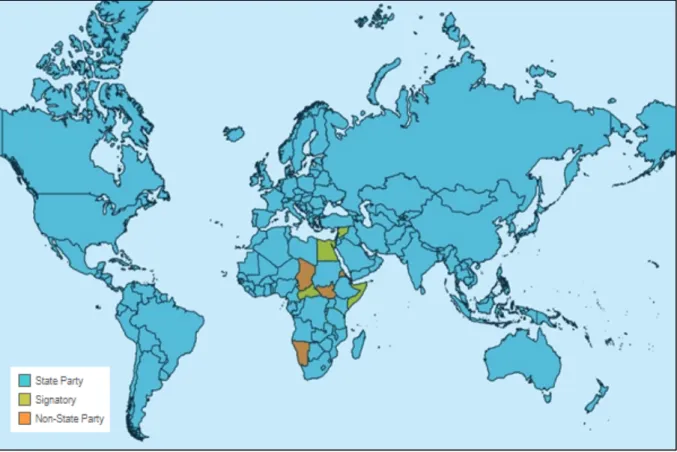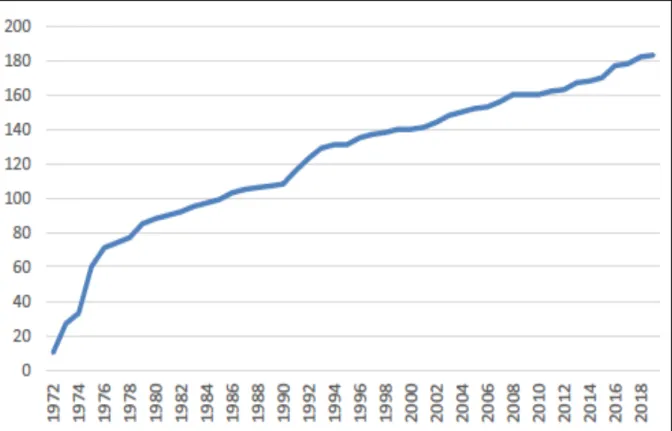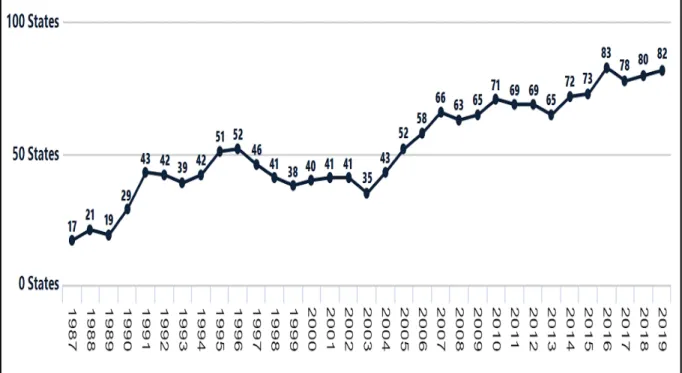Biological Weapons Convention: Issues and Challenges
Problem of Universality
- Why the BWC is not universal yet?
18 BWC, Article XIV, First Review Conference, BWC/CONF.1/10, “Final Declaration of the First Review Conference”. One of the most frequently mentioned obstacles to acceding to the Convention is the financial cost, especially for smaller countries.
Development in science and technology and Dual-use dilemma
- Scope of Science and Technology in the BWC
Men, moving forward: Trends in science and technology and the future of the Biological Weapons Convention, Bulletin of the Atomic Scientists. With which "Review of developments in the field of science and technology in relation to the Convention" is considered as one of the most important topics for the Meeting of Experts.
Problem of verification and compliance
The second chapter will discuss all these attempts to strengthen the structure of the BWC. The following pages describe the main mechanisms adopted by States Parties to address the BWC's institutional deficit.
Review Conferences
Confidence Building Measures
- Analysis of the States Parties participation in CBM
The first time that Confidence Building Measures were adopted under this name was during the final act of the Conference on Security and Cooperation in Europe (CSCE) in Helsinki (1975). 94 According to the records, two documented cases of national violations were brought to the BWC (Soviet Union and Apartheid South Africa), and other periodic allegations of violations, which undermine the credibility of the regime and create a state of uncertainty. One of the additional obligations agreed upon by States Parties at the second BWC Review Conference in 1986 was to share information on events related to the Convention.
It also requires information on the submitting country, including the national contact point.101. 101 United Nations, Guide to Cooperation in Confidence-Building Measures of the Biological Weapons Convention, 2015, 2. After the collapse of the Verification and Compliance Protocol negotiations in 2001, the possibility of using CBM to strengthen the BWC was brought back into focus; CBM was again the only opportunity for data exchange within the Convention.
The involvement of ISU has yielded great results reaching 83 participants during the Eighth Review Conference in 2016 as the highest participation since the establishment of the CBM. Proposals to strengthen the CBM regime stemmed from its failure to attract more participants over many years (quantity) and relative poverty in the quality of submissions; 2019 statistics show that 82 CBM participants have submitted their reports which means only 44% of the 183 States Parties to the Convention (See Figure 2),104 this number is still very low compared to the efforts made to increase the number of countries involved. , and also the expectations surrounding the CBM as one of the few hopes to increase the level of trust between the Party States. Additionally, CBM suffers from poor rendering quality; many of the CBM submissions are incomplete, inaccurate, or filled with unnecessary amounts of vague information.
The BWC verification protocol (1995-2001)
- What went wrong?
Mathews, "The Development of the Australia Group Export Control Lists of Biological Pathogens, Toxins and Dual-Use Equipment," CBW Conventions Bulletin. The main topic dominating the discussion was the technical feasibility of the verification mechanisms. Third Review Conference of the Parties to the BWC, Final Document, 1992, Geneva, BWC/CONF.III/23, 16.
The Fourth Review Conference, held in 1996, supported the Ad Hoc Group on the intensification of the verification protocol (Article V). Kristen Paris, "Expanding the Biological Weapons Convention: The History and Problems of a Verification Regime," Houston Journal of International Law. 123 BWC, Protocol to the Convention on the Prohibition of the Development, Production and Stockpiling of Bacteriological (Biological) and Toxin Weapons and on Their Destruction (Geneva, 3 April 2001).
One month later, on 7 December 2001, during the last day of the Fifth Review Conference, the United States unexpectedly proposed to terminate the Ad Hoc Group negotiating the Verification Protocol.125. Alternatively, the United States. Bush administration was that the measures proposed in the draft protocol would pose a risk to the U.S. Mathews, "The Development of the Australia Group Export Control Lists of Biological Pathogens, Toxins and Dual-Use Equipment," CBW Conventions Bulletin, No.
Establishment of the Implementation Support Unit
Unlike the NPT or the CWC and their permanent regulatory secretariats, the ISU is not an agency of the BWC. 142 The Seventh Review Conference renewed the mandate of the ISU up to and including the Eighth Review Conference in 2016. - secretariat.
148 BWC, Meeting of States Parties 2019, “Report on the Overall Financial Status of the Biological Weapons Convention”, 2. 152 Permanent Representatives of States Parties to the BTWC, Geneva, “Biological and Toxin Weapons Convention (BTWC) Estimated Contributions”, 21 March 2017, < https://bit.ly/2VbPCYC >. While States Parties lack sufficient data and information, the ISU has come together as an alternative that has a clearer view and broader picture of the BWC landscape.
For a period of time, States Parties saw confidence-building measures as the main key instrument for strengthening the institutional structure of the BWC. However, the voluntary nature of submissions produced a poor participation of States Parties in submitting their CBM, as well as a poor quality of reports. In plain English, States Parties began to address various topics and challenges related in part to the initial objective of addressing the Convention's institutional deficit.
Enhance the structure of the BWC through the establishment of additional measures
- Establishment of a comprehensive legally binding instrument under the 1994 mandate
- Establishment of peer-review mechanism
- Establishment of the Scientific Advisory Committee
Consequently, the chapter aims to answer the question: What measures can be adopted to further strengthen the structure of the BWC regime. 156 Protocol to the Convention on the Prohibition of the Development, Production and Stockpiling of Bacteriological (Biological) and Toxin Weapons and Their Destruction, accessed 20 May 2020, BWC/AD HOC GROUP/CRP.8. In addressing the structural aspect of the proposal, the Russian Federation introduces the OPBW as a new structure serving only the protocol.
In contrast, the proposal does not provide a clear picture of the relationship between the proposed OPBW and the ISU; it is still unlikely that the ISU will fall under the OPBW. Some noted that the composite text prepared by the Chairman of the Ad Hoc Group in 2001 was far from a consensus text. The mechanism will function through the existing structures of the BWC, in particular the ISU.
Advances in the life sciences and related fields have advanced exponentially since the signing of the Convention in 1972. The purpose of the Committee would be to assess and report to States Parties on developments in scientific and technological fields relevant to the Convention and to make recommendations as appropriate. Part of the problem lies in the background of rapid advances in life sciences and technology.
Enhance the effectiveness of existing measures in the BWC
- Enhancing the effectiveness of the Confidence Building Measures
- Enhancing the role of the Implementation Support Unit
- Enhancing the role of the Intersessional Process
- Enhancing the role of the International Organisations
Therefore, the unit plays a major role in promoting the institutional strengthening of the Convention through these relative subjects:183. Nevertheless, highly appreciating the ISU's efforts, the majority of States Parties believe that the role of the ISU should be strengthened to tackle all the challenges facing the BWC. There are a number of proposals that States Parties have made that may have an impact on the functions of the ISU.
It is noticeable that the role of the ISU has grown significantly over the years from a small secretariat to a truly significant influencer in the BWC. As well as strengthening the role of international organizations as one of the most prominent structures that could play an important role in supporting the BWC. Furthermore, strengthening the institutional deficit of the BWC cannot be effective without reference to the role of the Implementation Support Unit.
The future of the ISU is highly expected to be at the center of the discussions of the Ninth Review Conference in 2021. As all States Parties recognize the advantages of the ISU, reaching consensus on the role of the unit seems within reach. Source: Meeting of States Parties to the BWC, Report on Universalization Activities, BWC/MSP/.

Primary Sources
BWC, Sixth Review Conference of the States Parties to the BWC, Final Document, Geneva, 20 November - 8 December 2006, BWC/CONF.VI/6. BWC, Special Conference of the States Parties to the Convention, Final Document, BWC/SPCONF/1, Geneva: UN, 1994. BWC, Third Review Conference of the Parties to the BWC, Final Document, 1992, Geneva, BWC/CONF. III/23.
Ambassador Michael Biontino, Permanent Representative of Germany to the Conference on Disarmament, “First meeting of the Preparatory Committee for the Eighth Review of the BTWC Review Conference, Geneva, 26 April 2016. OPCW, “Technical Secretariat: Facilitating the Implementation of the Convention”, https://www.opcw.org/about-us/technical-secretariat Protocol to the Convention on the Prohibition of the Development, Production and Stockpiling of Bacteriological, Biological and Toxin Weapons and on Their Destruction, accessed 20 May 2020, BWC/AD HOC GROUP/CRP.8.
Second Review Conference of the Parties to the Convention on the Prohibition of Development, Production and Storage of Bacteriology (Biological). United Nations, Guidelines for Participation in Confidence-Building Measures of the Biological Weapons Convention, 2015. United Nations, Protocol to the Convention on the Prohibition of the Development, Production and Stockpiling of Bacteriological (Biological) and Toxin Weapons and on Their Destruction, Geneva, 3 April 2001.
Secondary Sources
Mahley, Statement by the United States to the Ad Hoc Group of States Parties to the Biological Weapons Convention, Geneva, July 25, 2001. Filippa Lentzos, Strengthening the Confidence-Building Measures of the Biological Weapons Convention: Against the Cycle of Cooperation, Bulletin of the Atomic Scientists, 2011. Jenni Rissanen, " Biological Weapons Convention,” Nuclear Threat Initiative, accessed May 12, 2020, https://www.nti.org/analysis/articles/biological-weapons-convention/.
John Hart, Ralf Trapp, Science, Technology, and the Biological Weapons Convention, tilgået den 13. november 2019, https://bit.ly/36jq2VV. Husbands, Moving forward: Trends in science and technology and the future of the Biological Weapons Convention, Bulletin of the Atomic Scientists 67:3, 2011. Chevrier, “Doubts about Confidence: The Potential and Limits of Confidence- Building Measures for the Biological Weapons Convention”, i: Graham S.
Olivier Meier, Verification of the Biological Weapons Convention: What is needed?, Medicine, Conflict and Survival. Richard Lennane, Building on Success: The Future of the Intersessional Process, and Improving Implementation of the Biological Weapons Convention The 2007–2010. Wanda Archy, “The Biological Weapons Convention (BWC) at a Glance,” Arms Control Association, https://www.armscontrol.org/factsheets/bwc.

